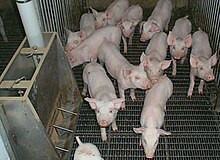Pig farming
This article is about pig farming. There are various methods of pig farming depending on the method of management adopted;
- Level of management skills available
- Money or capital available
- Type of animals kept
- Local requirements and sale
Pigs can be farmed in free range, being allowed to wander around a village, or kept in fields, or tethered with a simple house. In developed countries farming has moved away from traditional pig farming and now they are typically intensively farmed
Individual farm management focus on, housing facilities, feeding and ventilation systems, and temperature and environmental controls and the needs of economic viability. Just as producers have to determine the profit margin,type of facilities and equipment for their farm, they must also find the practices that best fit their farm’s specific situation. Some procedures and treatments are known to stress the animals and producers should consider the animals welfare, health and management with accepted husbandry skills.



Use as food
Almost all of the pig can be used as food. Preparations of pig parts into specialties include; sausage, bacon, gammon, ham, skin into pork scratchings, feet into trotters, head into a meat jelly called head cheese (brawn) and consumption of the Liver, chitterlings, blood (blood pudding or black pudding) are common.
Pig farming terminology
| Global pig stock | |
|---|---|
| in 2007 | |
| Number in millions | |
| 1. | 425.6 (46.35%) |
| 2. | 61.7 (6.72%) |
| 3. | 35.9 (3.91%) |
| 4. | 27.1 (2.95%) |
| 5. | 26.6 (2.9%) |
| 6. | 26.1 (2.84%) |
| 7. | 18.1 (1.97%) |
| 8. | 15.9 (1.73%) |
| 9. | 15.5 (1.69%) |
| 10. | 14.9 (1.62%) |
| World total | 918.3 |
| Source: UN Food and Agriculture Organization | |
Because pigs have been extensively farmed, terminology is well developed.
- Pig, hog or swine, the species as a whole, or any member of it. The singular of "swine" is the same as the plural.
- Shoat, piglet or (where the species is called "hog") pig, unweaned young pig, or any immature pig.
- Sucker, a pig between birth and weaning.
- Runt, an unusually small and weak piglet, often one in a litter.
- Boar or hog, male pig of breeding age.
- Barrow, male pig castrated before puberty.
- Stag, male pig castrated later in life, (that is, an older boar after castration).
- Gilt, young female not yet mated, or not yet farrowed, or after only one litter (depending on local usage).[1]
- Sow, breeding female, or female after first or second litter.
Pigs for slaughter
- Suckling pig, a piglet slaughtered for its tender meat.
- Feeder pig, a weaned gilt or barrow weighing between 18 kg (40 lb) and 37 kg (82 lb) at 6 to 8 weeks of age that is sold to be finished for slaughter.
- Porker, market pig between 30 kg (66 lb) and about 54 kg (119 lb) dressed weight.
- Baconer, a market pig between 65 kg (143 lb) and 80 kg (180 lb) dressed weight. The maximum weight can vary between processors.
- Grower, a pig between weaning and sale or transfer to the breeding herd, sold for slaughter or killed for rations[clarification needed].
- Finisher, a grower pig over 70 kg (150 lb) liveweight.
- Butcher hog, a pig of approximately 100 kg (220 lb), ready for the market.
- Backfatter, cull breeding pig sold for meat; usually refers specifically to a cull sow, but is sometimes used in reference to boars.
Groups
- Herd, a group of pigs, or all the pigs on a farm or in a region.
- Sounder, a small group of pigs (or wild boar) foraging in woodland.
Pig parts
- Trotters, the feet of pigs (they have four hoofed toes, walking mainly on the larger central two).
Biology
- In pig, pregnant.
- Farrowing, giving birth.
- Hogging, a sow when on heat (during oestrus).
Housing
- Sty, a small pig-house, usually with an outdoor run or a pig confine meant.
- Pig-shed, a larger pig-house.
- Ark, a low semi circular field-shelter for pigs
- Curtain-barn, a long, open building with curtains on the long sides of the barn. This increases ventilation on hot, humid summer days.
See also
- Animal slaughter
- List of pig breeds
- ECODIPTERA
- Exotic pet
- Extensive farming
- Factory farming
- Intensive farming
- Intensive pig farming
- Miniature pig
- Taboo meat
- Iron Age pig
Notes
- ^ Swine Study Guide from UC Davis

